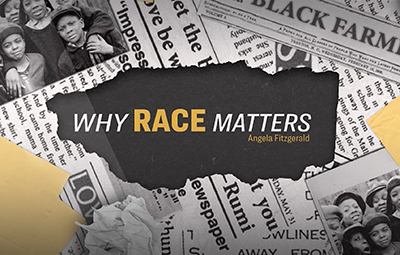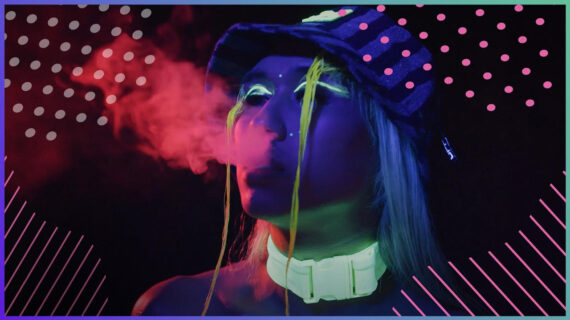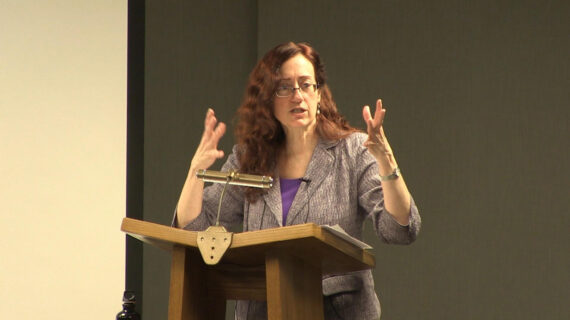– Welcome everyone to Wednesday Nite @ the Lab. I’m Tom Zinnen, I work here at the UW-Madison Biotechnology Center. I also work for the Division of Extension. And on behalf of those folks, and our other co-organizers, Wisconsin Public Television, the Wisconsin Alumni Association, and the UW-Madison Science Alliance, thanks again for coming to Wednesday Nite @ the Lab. We do this every Wednesday night, 50 times a year. Tonight it’s my pleasure to introduce to you Emily Ward. She’s an assistant professor in the Department of Psychology here. She was born in Santa Cruz, California. And went to high school at– excuse me, at Pacific Collegiate School in Santa Cruz. And then she did her undergraduate degree in neuroscience at Franklin & Marshall in Lancaster, Pennsylvania.
Then she went to Yale, to get her master’s and her PhD in psychology. Then she did a postdoc at the Donders Institute in Nijmegen, in the Netherlands. And then she came to the UW-Madison here, and the Department of Psychology, in 2017. Tonight she’s gonna talk with us about Seeing and Not Seeing: Investigating Visual Awareness. Let’s see what she has to say. [audience laughing] Look forward to hearing this, please join me in welcoming Emily Ward, to Wednesday Nite @ the Lab. [audience applauding] Thank you very much.
– Thank you all for coming out. I’m very excited to be here. This is my first time as part of this series.
And I’m excited to talk about some of my research. So, as a psychologist, I’m interested in the mind. And in particular, I’m interested in the relationship between the mind and the world. How does everything that’s out here, get into the mind? And the first step in understanding the relationship between the mind and the world, is understanding how we become aware of the world to begin with. This may seem very straightforward, after all, we walk around every day, seeing things, noticing things. So this may seem like a weird type of topic to study. But what I hope to show in this talk, is that this relationship between the mind and the world, is governed by our awareness. And that what we become aware of, is not as straightforward, and can be very counterintuitive, and interesting in many ways that you might not ordinarily think about. So, to motivate my research, I want to present an example that I hope not too many of you have experienced, to give you a sense of how there is a disassociation between what goes on in the world, and our awareness of it. And that example is a car crash.
So just to put what you just saw, in perspective. Make it a little bit more concrete. This is a timeline of what went on, in that previous film. At zero milliseconds, the external object hits the car. The events unfold, such that at about 27 milliseconds, the impact velocity is halved. The airbag is starting to control its deflation. So on and so forth. At 70 milliseconds, the airbag continues to deflate and the occupant moves back to the middle of the car. And what’s interesting is, at this point, the 70 milliseconds, this is what engineers would say is a completed car crash. And so, one thing that might be missing for you in this picture, is that it’s not until a 150 to 300 milliseconds after the initial impact of the car, that the occupant even becomes aware that a crash has occurred in the first place.
And I like this example, because it gives you an idea of this disassociation between the mind, and the world. And some of my research has been focusing on that disassociation. In particular, looking at spectacular examples, where we fail to become aware of things in the first place. So in the course of this talk, I hope to convince you of three things. The first is that you don’t see as much as you think you see. The second is that what you do see, can be surprisingly sophisticated, and counterintuitive. And finally, I’ll end with something a little fun, talking about how your awareness can be altered by information that you don’t even know exists in the first place. So a car crash is a little grim to start out a talk with. So I’d like to give another example, [audience laughing] of how your sense of what you can be aware of, is a little different than maybe what you think it is. So there’s no task in this part, you guys can just watch this video.
[lively piano music]
– Clearly, somebody in this room, murdered Lord Smythe. Who, at precisely 3:34 this afternoon, was brutally bludgeoned to death with a blunt instrument. I want each of you to tell me your whereabouts at precisely the time that this dastardly deed took place.
– I was polishing the brass in the master bedroom.
– I was buttering his lordship’s scones belowstairs, sir.
– Why, I was planting my petunias, in the potting shed.
– Constable, arrest Lady Smythe.
– But, but how did you know?
– Madame, as any horticulturist will tell you, one does not plant petunias until May is out. Take her away. [audience laughing] It’s just a matter of observation.
The real question, is how observant were you?
– Emily: Anybody? [audience murmuring] We’ll see this again.
– Director: And action.
– Clearly, somebody in this room, murdered Lord Smythe. Who, at precisely 3:34 this afternoon, was brutally bludgeoned to death with a blunt instrument. I want each of you to tell me your whereabouts at precisely the time that this dastardly deed took place.
– I was polishing the brass in the master bedroom.
– I was buttering his lordship’s scones belowstairs, sir.
– Why, I was planting my petunias, in the potting shed.
– Constable, arrest Lady Smythe. [audience chuckling]
– So, obviously, I’m giving a talk about visual awareness.
And I’m sure some of you were a little skeptical that this would be a straightforward movie, and were looking for particular changes. But even if you did notice some of the changes, I bet none of you noticed 21 of these changes. Even though, when you see it after the fact, these are pretty big changes. These are entire people changing, these are entire paintings changing. There is nothing very small about these types of changes. And so what happened here, was that you collectively experienced what I’m going to call a failure of awareness. This is failing to notice something that’s otherwise pretty noticeable in the environment, if you were paying attention to it. And some of you are probably familiar with some of the most famous cases of this. Whenever you’re talking about failures of awareness, most people out in the world, probably most people in this audience, most incoming psychology students, are aware of a particular example, which is more commonly known as the gorilla experiment. This experiment was made famous by a group in the mid-90s.
And what happens in this, is that there is a group playing basketball. And you as a participant, would be paying attention to a subset of the number of players. So, for example, you might be paying attention to how often the white players pass the ball back and forth. Meanwhile, in the middle of your task, which is pretty difficult, keeping track of the basketball, with only the subset of these players in white T-shirts, a man in a gorilla suit walks through the middle of the display. Most people don’t notice this the first time they see it. If you guys are familiar with this, and this is why I don’t use this, is you do see it. Once you’re aware of it, you have an expectation about what’s gonna happen, and it undermines this effect. But this effect, has been called inattentional blindness. That you’re blind to things you would otherwise notice because your attention is engaged. But there is, despite how famous this example is, there is still a fundamental question about what the nature of this deficit actually is.
Is it in fact, a type of blindness, as the name suggests? Meaning that this is a failure of perception. That you really just don’t see that gorilla, as it passes through the basketball game. Or is it something a little bit different? Is it a failure of your memory? And what I mean by failure of memory, isn’t just that you forget where you put your keys in the morning. It’s something a little bit more subtle. And so to give you an idea of what exactly I mean by failure of memory, I’m going to have you watch another little video. In this video, this is what’s known as a rapid serial visual presentation display. RSVP for short, that’s not important, what is important is you’re gonna see a bunch of letters. They’re gonna be presented very quickly at the center of the screen. And I just want you to pay attention to them as best you can. All right.
Can anybody tell me exactly which letters you saw, in order? [audience murmuring] You can’t, right. I can’t, I’ve seen this a lot, and I still can’t. But you wouldn’t say you didn’t see them, in the moment. If it was anything like my impression, it’s that you have this fleeting sense of what you see, and then it’s gone. So that’s what I mean by a failure of memory. That simply because you can’t tell me what you saw after the fact, doesn’t mean you didn’t see it in the first place. Let me contrast that with the typical story about inattentional blindness. Where I’m looking specifically at what you can tell me about it, what you expect, and what I can infer about your experience. So in the inattentional case, you don’t have any instruction to report what you’re gonna see. You have a task that’s keeping your attention, but nothing else.
As a result, you have no expectation of what’s going on. And then, your experience is that you’re unable to report what was present. Contrasting that with what I just showed you with the letters. A memory deficit gives a very similar account. Except that if I wanted to test whether or not you really saw a particular letter, I would tell you to beforehand, clap if you saw the letter M. Or the letter A, I think is my example here. So if I give you that instruction, to clap when you see an A, you then expect that you may or may not see an A. And then you can tell me if you saw it or not. And so this is how I would rule out whether or not you failed to see, or saw a particular letter, in the letter display. Can I apply this same logic to an inattentional blindness case? So for example, if I gave you the instruction to report if you saw anything unusual, you would then expect something unusual.
And in that case, you can report whether or not you saw something unusual, like a gorilla, for example. But because you were expecting it, that would rule out the effect to begin with. So the very thing that I’m interested in measuring, just by telling you that it might happen, undermines inattentional blindness. And so you can see that getting around this, experimentally, is a little tricky. How do you figure out if people are really blind to a gorilla, or if they’re just failing to report in the same way that you all failed to report the stream of letters. So, just to highlight, disentangling this idea that this effect might be a failure to see, or just a failure to remember, is a bit of a catch-22. And I think I might have a way around this. And so I’m gonna tell you about a minor change that I made this logic, to see if I can figure out what the true nature of this effect really is. So what I did in this particular study, is instead of giving you no report, and having you have no expectation, I wanted to see if I can manipulate your expectation. So instead of having no expectation whatsoever, I wanted to have you expect something unusual.
But expect only a very particular type of unusual event. And this, I hoped, would be something that would allow me to see whether or not people could report the presence of something unusual, but maybe would still fail to see something that violated that expectation. So, because these types of experiments are very famous, and I can’t show people gorillas out in the wild for example, we use a different type of display. And so again we’re using simple letters in this. And I’ll give you a sense of what this looks like. But what we show participants in these types of studies is a computer display where there’s a bunch of letters. Some of them are Ts, some of them are Ls. Some of them are white, some of them are black. And they’re moving around randomly on the display. And subject’s task is to count how many times a subset of them, so in this example it’s the white Ls, cross that middle line.
So every time they cross that, you have to keep track of that. If you wanna give this a shot, I’ll show you what a typical trial looks like. Any numbers?
– Audience: Five.
– All right, you guys are doing great. So it’s not impossible, but it’s tricky. You have to pay attention. And so, because this is a talk, and I’m talking about inattentional blindness, I am allowing you guys to know that something might have happened. Nothing happened on this one, but when I showed this to subjects in the lab, I had another trial, which is similar, except now, something slightly different occurred. How many of you noticed that there was a gray cross that went along the middle of the screen? And how many of you noticed the gorilla? [audience laughing] All right, so hopefully for some of you, you still may have missed that cross. This does work particularly well.
But there was a slow gray cross, that was on the screen for about five to ten seconds. It’s right where you’re paying attention, so I’m not trying to trick you by having it appear in some peripheral location. This is the type of unexpected event that I used in this study. And so how a typical experiment goes, is that participants will see about four trials or so, where only the letters are being presented. And so that gets them used to the task. And then on the fourth trial, a red cross appeared in this. And so it looked something like this. This is a typical way of studying inattentional blindness. And what you then would ask is, “Did you notice anything different?” And then ask specifically, “Did you notice if a red cross appeared?” And if a participant said that they didn’t notice anything, and they didn’t notice a red cross, I would categorize this as them being inattentionally blind in this case. Typically, about 50% or 60% of people miss this type of cross.
Previous experiments have stopped here. But I decided to keep going. And I gave people the instruction that any time you see anything different or unexpected, immediately press the space bar, and we’ll ask you to identify it. So this is giving them the instruction to immediately report what they see in the moment. Then I continued on with the trial structure. There was a few more trials where nothing happened. But importantly, there was a few more trials where the red cross appeared. So they were building up this expectation that there might be something unusual. But that unusual event was the presence of a red cross. Importantly, at the very last trial, it was a critical trial, where half of the subjects saw a new event.
In this case, it was a blue E, moving the opposite direction on the screen. Or just another instance of the red cross moving across the screen. And the question is, if people are presented with something that violates their expectation about what’s going to occur, do more people miss this new, unexpected event, compared to just another instance of the repeated unexpected event. So I’m gonna show some data that answers this question. So here I’m plotting the percent of people who miss the unexpected event on this critical trial, by what type of event it was. Was it the new one, or just the repeated one? So first of all, I measured how many people missed this repeated event. A few people, while they were doing the counting task, did miss it, but it’s not very many. Critically, almost five times the amount of people missed this new unexpected event. So this means that more people are missing that event even when they’re given that instruction, and even when they’re willing to respond immediately to what they see on the screen. So what this means, is that you don’t see as much as you think you see.
And that this phenomenon of inattentional blindness arises specifically due to you having the wrong expectation about what’s going to occur out in the world. And that this phenomenon also reflects the limitation of perception, and not of your memory. So this has implications for the real world. This means that if you are driving while distracted, and a child runs out in front of your car, and you hit it, that’s not because you saw it and then forgot, in the way that you would see these letters that I presented earlier, and forgot. It’s truly reflecting a limitation of your perception because your attention is otherwise engaged. So, this is a good example of how limited what we see can be. But it stands in contrast to what we think our daily experience actually is. So why does it seem like we see so much, when I demonstrated just now that our experience is limited by these limitations in perception. So I’m gonna show another video right now. No task.
Just sit back and take this in. So just like before, if I were to ask you what exactly you saw, in order, you probably wouldn’t be able to tell me. You can recognize these types of scenes very very quickly if you know what’s going on beforehand, but also if you don’t know what’s going on beforehand. And it also just strikes you as really rich. You see a lot of detail. You see exactly what’s going on. These pictures seem evocative. They seem beautiful, they seem interesting. And you can do all this, even though this is presented very quickly. So this is in contrast to what I just showed you, where we can be really bad at seeing noticeable events or changes out in the world.
But we also feel like we’re really good at noticing rich detail. How do we reconcile these two experiences? Is it that we have a limited awareness of detail? But we are instead aware of some statistical properties of the world, that make our experience seem so rich. So, I’ll unpack that a little bit. I teach statistics here, so I know when I mention that, a lot of people’s eyes glaze over. And they think this is what I’m gonna be talking about. That’s not really what I mean in this particular case. Even in general, it’s not really what I mean. What I’m talking about is, do we perceive statistical properties? And so what that means is that if I put up a display like this, and give you guys the task right now to tell me what side, right or left, has the biggest average size circle. Can you tell me which one you would guess?
– Audience: Left.
– All right, average is a statistical property.
So here, you’re doing some computation, over all of these elements. And telling me that you can see that these left side, contains a bigger average size. I’m gonna give you another one. This one’s gonna be a little bit trickier, and I’m also not gonna present it for very long. So again, which side, right or left, has the bigger average size circle.
– Audience: Right.
– Right, okay, you guys are doing great. So that’s completely true. And what’s interesting about what you just did, ’cause those were only presented for about a second or so. So it’s enough time to do a lot of processing.
But it’s not a whole lot of time to make a cognitive decision about it. And what’s interesting in this case, is that you also were able to discount the largest circle. So the largest circle of all of these circles was actually on the left side, but on average, you’re discounting that, and just taking that average statistical property. So you were able to do this statistical calculation. But what if I asked you, was this particular circle in the display? [audience laughing] So this is motivating my question. Can we perceive statistical properties without actually being aware of the individual elements that give rise to the statistical properties? So the example I just gave was an average. For those of you who remember statistics, that’s not the only important property when you are looking at an array of things. Another one is the diversity or the variance in them. So here, instead of looking at size, I’m looking at color. So, on one side, and I think this works for even those of you who might be color-blind.
Can anybody tell me the difference between the right and the left here? [audience murmuring] Yes, exactly, so on the left, this is colors drawn from a low diversity circle on the color wheel. So only sampling from ones from this area. Whereas the ones on the right are drawn from high diversity. I’m taking them from anywhere on this color wheel. And so this is an interesting type of statistic. This is looking at the diversity of a set of things. In particular, looking at the diversity in color. This type of display can also be used for me to figure out what kind of details do people notice. So I can then ask, are people aware of any individual element in these types of displays? Or are you aware of the statistics of this ensemble of dots for example. And it’s hard to do this with shapes like this.
So I can do one thing that makes it easy for me to figure out what specific details you know about each individual element. And that’s to translate them into letters. I can ask you both then, about the colors, and about the identity of a particular letter. I can ask you what letter was at that particular position, while also having you pay attention to whether or not the color of the display on the whole, came from a high diversity or low diversity color space. So this question, just to reiterate, do you perceive ensembles without perceiving the individual elements? How this type of study worked was that I would cue people beforehand, to pay attention to a particular row that was going to be displayed. And so even though I’m gonna be presenting a lot of letters, your attention is gonna be limited to a particular part of the display. Then I’ll show the display, this is 300 milliseconds. This is plenty of time to become aware of things. Remember from the beginning, at that point you know your car has crashed, and so it’s fast, but you can still do a lot of processing with that type of presentation speed. Then after a blank interval, I will ask you about a particular letter, at a particular place.
So you tell me what appeared right there. And then I can ask you what was the color diversity. Was it high or low? And I can ask you that about the row that you were paying attention to, or to the rows that you weren’t paying attention to. First, letter recall, how good are people at this type of task? So here, I’m plotting accuracy. Here, chance is I think about 12%. So, how good were people? And this is when they’re either attending to the color of that row, or attending to the color of the non-cued rows. So, does splitting your attention for the color task hurt your ability to tell me what a particular letter was? And it does not. People are fantastic at this task. You guys will be surprised, I will show you what this looks like in a little bit. But people are very good at identifying letters, even when these displays are presented for just 300 milliseconds.
And splitting your attention between the two different types of rows. Either the cue, or non, doesn’t hurt your performance. What about color diversity? Here chance is 50%, because it can either be high or low if you’re guessing. Again, people are very good at this task. And it doesn’t matter if they’re paying attention to the color diversity of the cued row or the non-cued row. They’re just as good at either of those. So overall, we’re back to this story, of looking at whether or not people are doing these tasks. Because they are aware of every single element. Or if they are aware of just the ensemble without the elements. Both of these theories have predictions about how good you should be at letter recall and color diversity.
So if you’re aware of all of the elements, obviously you’re gonna be good at recalling letters. If you’re aware of the ensemble without the elements, you still have some access to some detail, otherwise we wouldn’t be able to read, or recognize people. So both of these predict that you should be good at both of these, at the letter recall. You can do the color diversity task either by having an ensemble, statistical processing going on, or because you’re processing every single element, and then doing the computation that gives you the ability to say whether or not it was high or low diversity. So again, both of these don’t make any different distinguishing between these two theories, based on this result alone. What I needed was some way to distinguish these. And particularly, I wanted to see whether or not people notice changes to the elements. So if you are aware of everything, if I change anything, you should be aware of that. You should notice that. And so that theory predicts that you would be able to notice changes to the elements.
However, if you are aware of an ensemble without perceiving each element, you may not notice changes to any or all of the elements. As long as the statistical properties remain the same. So, to manipulate that, I’m gonna show you what this display actually looked like. So here, just so that people had enough time to see what the colors were, the display starts with these zero figures before switching to numbers. And so this is what an actual, several trials of this looked like for participants. [audience murmuring] All right, so it’s pretty surprising, but people were very good at this. Was there anything else anybody noticed about these displays, besides just that it seems like a very difficult kind of experiment?
– Woman: The second one changed colors.
– All right, they all changed colors, actually. So, the cued row didn’t, but every other element in this display changed color on every single trial that you just saw. And so maybe some of you are saying, “Well come on, that was super fast.
“There’s no way anybody would’ve noticed those, “even in principle. ” So I’m gonna show you it again, with a particular type of instruction. So, what will help you to see that these are not completely unobvious changes, is if you pay attention to a subset of this display. So, I want you to try as best as you can, to pay attention to both of those positions. Because then, regardless of what I cue, one of them will be changing, okay? So you got that? So pay attention to the letters that will appear at both of those positions. All right, so hopefully, you were able to notice them much better then you were the first time. It’s still tricky, it’s not the most obvious change in the world, but the idea is, if you are perceiving every single one of these elements, you should be able to notice at least one of these changes, across the experiment. And so I did two experiments with this. And they’re fairly small in nature. But nobody of the 12 observers, in either of these, noticed any of these changes.
And if you actually do the math on this, there’s 18 letters that were changing on every trial. There was a 192 trials in which there was a change. And that means, there was 3,456 possible changes for you to notice. So, that nobody noticed any of these, really starts to lend support that you are perceiving the color of these displays, the color diversity of these displays, without perceiving the individual elements. So this really supports this idea that we have this sophisticated statistical processing that’s going on, even when we aren’t aware of it at all. So why does it seem that we see so much richness based on the other types of failures of awareness? Well, it could be that we are aware of these types of statistical properties. We’re aware of averages. We’re aware of variants. And we’re not actually processing consciously all the individual details at any given time. And so this gives an account of why it seems like the world is rich, while we can still miss critical details in the environment.
So finally, I wanna end with a fun, smaller experiment. Trying to see how our conscious experience can be altered. And what type of information can alter what our experience is. And particularly asking this question, of whether or not our awareness can be altered by information that we aren’t aware of at all. So I showed that we aren’t aware of a lot. But what kind of functional role does that play in governing our moment to moment experience? So there’s particular examples that I’m sure you guys have had a lot of exposure to, even if you don’t study vision like I do. And particularly these types of images, ambiguous images. This one’s called a Necker cube. And what you are probably doing right now, is paying attention to different aspects of this cube. And depending on where your attention is, you can see it in one of two interpretations.
You can either see it as going away from you, or you can see it as coming towards you. Sometimes you can do this willingly, but a lot of times, it just seems kind of random. It seems like what you’re experiencing is just driven by something that you don’t have any control over. You see the alternations between these two types of interpretations of this cube, without having any conscious control over it. So this is a famous example that’s used in a lot of different types of studies. But there’s also examples of these types of ambiguous images out in the wild. And one that you may have seen, it got famous on the internet a little while ago, is one that looks like this. So I think this should work. So this is a dancer that is ambiguous in depth. She is just a silhouette, so you don’t get any depth information.
And as a result, your brain really doesn’t know which way she’s turning. But, you can’t see both interpretations, left or right, turn at any time. And so your brain makes a decision about what you see. So how many of you see her going clockwise? All right. [audience chuckling] Counterclockwise?
– Woman: Yeah.
– How about anyone who’s seeing it flip back and forth?
– Woman: Yep.
– Man; Yeah, I just did.
– All right. So, most people will see her going clockwise. That’s the predominant way that this is interpreted.
There’s a couple of different reasons for that. One is that her foot is angled a little funny. And one interpretation, I think counterclockwise, your brain would just have to decide you’re looking at her foot from below, which is a weird way to look at feet. So, it’s also dictated by how fast she’s going. There’s a lot of different things that you can do to manipulate it. But the idea is, this can go both ways. And so just to make that clear, for those of you who weren’t able to see her going both ways. If I put a cue on her, that helps you see her. So this effectively disambiguates her direction. This takes that ambiguous information about her depth, and by putting eyes on her, makes it so that she has to be going one direction.
So, on the right here, she’s going clockwise. And hopefully, if you pay attention to her face, that might help. And here, she’s going counterclockwise. And what’s fun about this one, is because clockwise is so strong for a lot of people, her body can start to look like it’s doing some very funny things. [audience laughing] And then again, there is this ambiguous interpretation in the middle, where it could go either way. My question was, can we make you switch? Your perception of her direction. And in particular, even if you’re not aware that we’re making you switch. And so how this worked, was that I showed you one version of the disambiguated figure. Which, again, tells you that she has to be going one way or the other, by putting eyes on her. Another way to do that, is to put very subtle contour cues on other parts of her body, in particular, her legs.
So for example, here is exactly the same frame from the animation, but it has different contour cues. So this one indicates that her leg has to be facing forward. The other one indicates that her leg has to be facing backwards. And so by putting these types of contour information, it is telling your brain that there is a correct interpretation of an otherwise ambiguous figure. And so the idea was, can we introduce these types of cues to people? And have them basically forcibly, have their perception of her direction be switched, even when people don’t notice these cues were there at all. So, to you guys, it just looks like a continuous movie, as it did to the participants in this experiment, but of course it can be broken down into individual movie frames. And so the idea was, we had people come in and they had the task of pressing the left or right arrow key, to indicate which direction they thought she was spinning. And so this was a fairly boring experiment for subjects who believed they were watching this spinning dancer for about 45 minutes, pressing a button, one way or the other. Unbeknownst to them, on certain frames of this, we would introduce one of these disambiguating contour cues. We would have a cue, and then the idea would be to measure, do people switch, shortly thereafter? Having seen this, having been presented with this cue, but not necessarily noticing it or seeing it.
And so again, because we’re interested in whether or not we can make you switch, even if you’re not aware of it, we only included people who said that they never saw any of these contour cues. After the fact, we always talked to the subjects about what they think the experiment was about, what their experience was, and so anybody who saw them, we didn’t include. We only included people who said they had no idea that there was anything like that present at any of that 45 minutes. So, to measure this, we would have the whole segment of the movie broken up into frame segments. We would have a cue presented, and then we would look for a switch that happened after the cue. This could be a fairly short time period after, it could be a different point in the different frames. We could measure the reaction time there, after presenting the cue, or we could look at a much longer duration. The idea was that any time after presenting the cue, if people are switching, above what they do, just by baseline, that would mean that something that we’re presenting, unconsciously to subjects, is influencing what they see. So, to make sure that we have captured this, we can take all the time points where a cue was presented, and line them up. And then basically count how many frames after that produced a direction switch.
Does that make sense? We’re basically time-walking the whole thing to the presentation of these unconscious contour cues. So, I’m gonna show here the amount of switching above a baseline that we measured for each subject, because some people unfortunately sat in there the whole time, and didn’t see it switching direction once. And so on the X is how much time passed after the presentation, and on the Y is the amount of switching that occurred. And so what you see is that, in the first second or two after presenting these cues, the unnoticed contour cues caused people’s perception of the dancer’s direction to switch. And so this means that even though they didn’t notice it, and they thought their behavior was just random, we were actually causing their behavior to change. So can awareness be altered by information that you don’t even know exists? Yes, it can. What you experience can be governed by information that you had no awareness of whatsoever. And also another thing that’s interesting about this experiment, is that the feeling of randomness that you may have, just going through your daily day life, doesn’t necessarily mean that there isn’t systematic processing going on, unconsciously, in visual perception. Your brain was interpreting these cues in a way that made sense. It wasn’t just randomly having these direction changes.
It was interpreting them, even though you weren’t aware of it. So, overall, I hope that I’ve convinced you that you don’t see as much as you think you see. And that what you do see can be much more sophisticated than you may realize. And that your awareness, and your everyday moment to moment experience of the world, can be governed by information that you don’t even know exists. So overall, how the world fits into the mind is governed by this process of becoming aware of it in the first place. And hopefully now, you all have a little bit more appreciation for how sophisticated and counterintuitive and interesting this process is. Thank you. [audience applauding]
Search University Place Episodes
Related Stories from PBS Wisconsin's Blog

Donate to sign up. Activate and sign in to Passport. It's that easy to help PBS Wisconsin serve your community through media that educates, inspires, and entertains.
Make your membership gift today
Only for new users: Activate Passport using your code or email address
Already a member?
Look up my account
Need some help? Go to FAQ or visit PBS Passport Help
Need help accessing PBS Wisconsin anywhere?

Online Access | Platform & Device Access | Cable or Satellite Access | Over-The-Air Access
Visit Access Guide
Need help accessing PBS Wisconsin anywhere?

Visit Our
Live TV Access Guide
Online AccessPlatform & Device Access
Cable or Satellite Access
Over-The-Air Access
Visit Access Guide
 Passport
Passport


















Follow Us